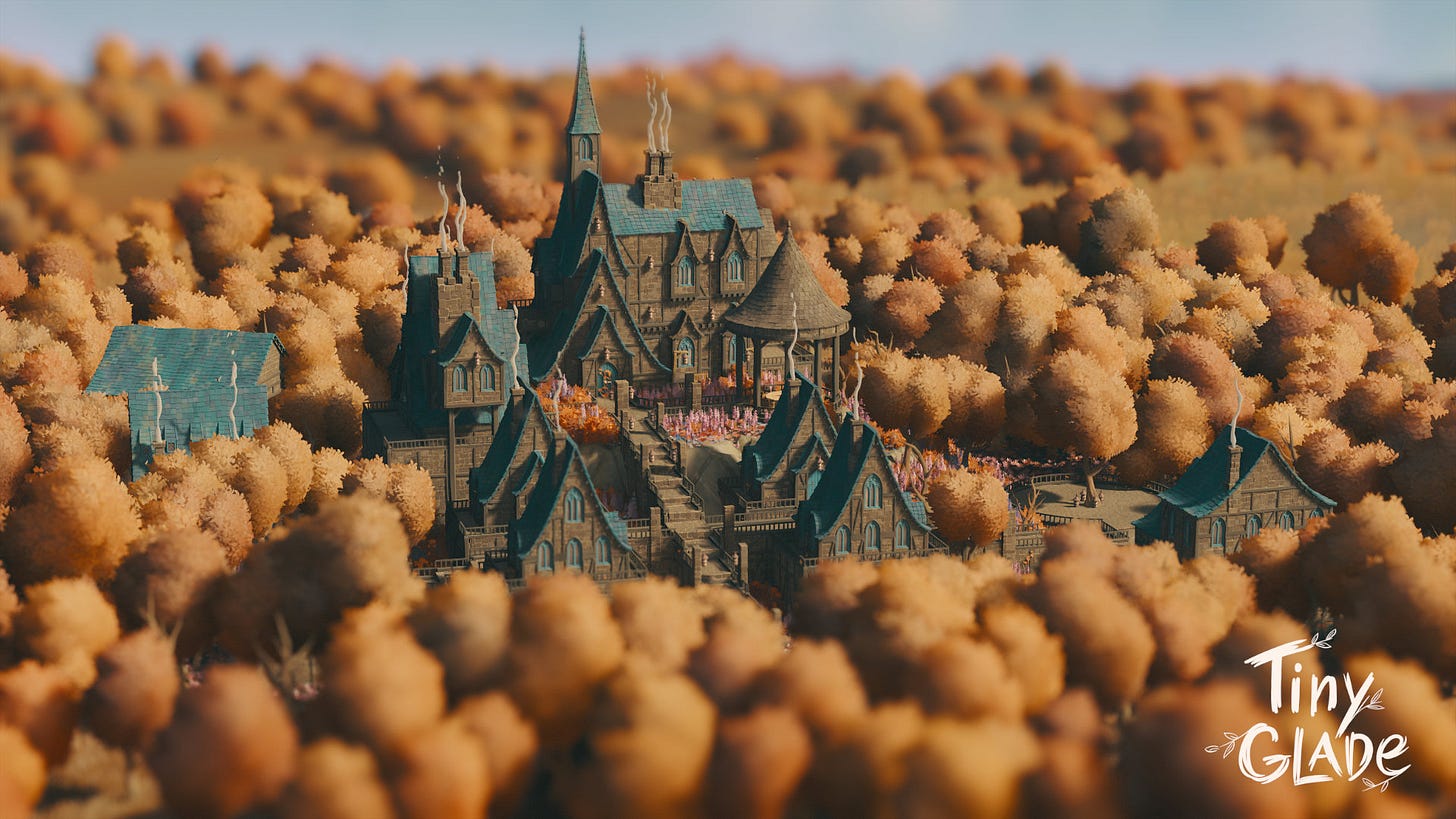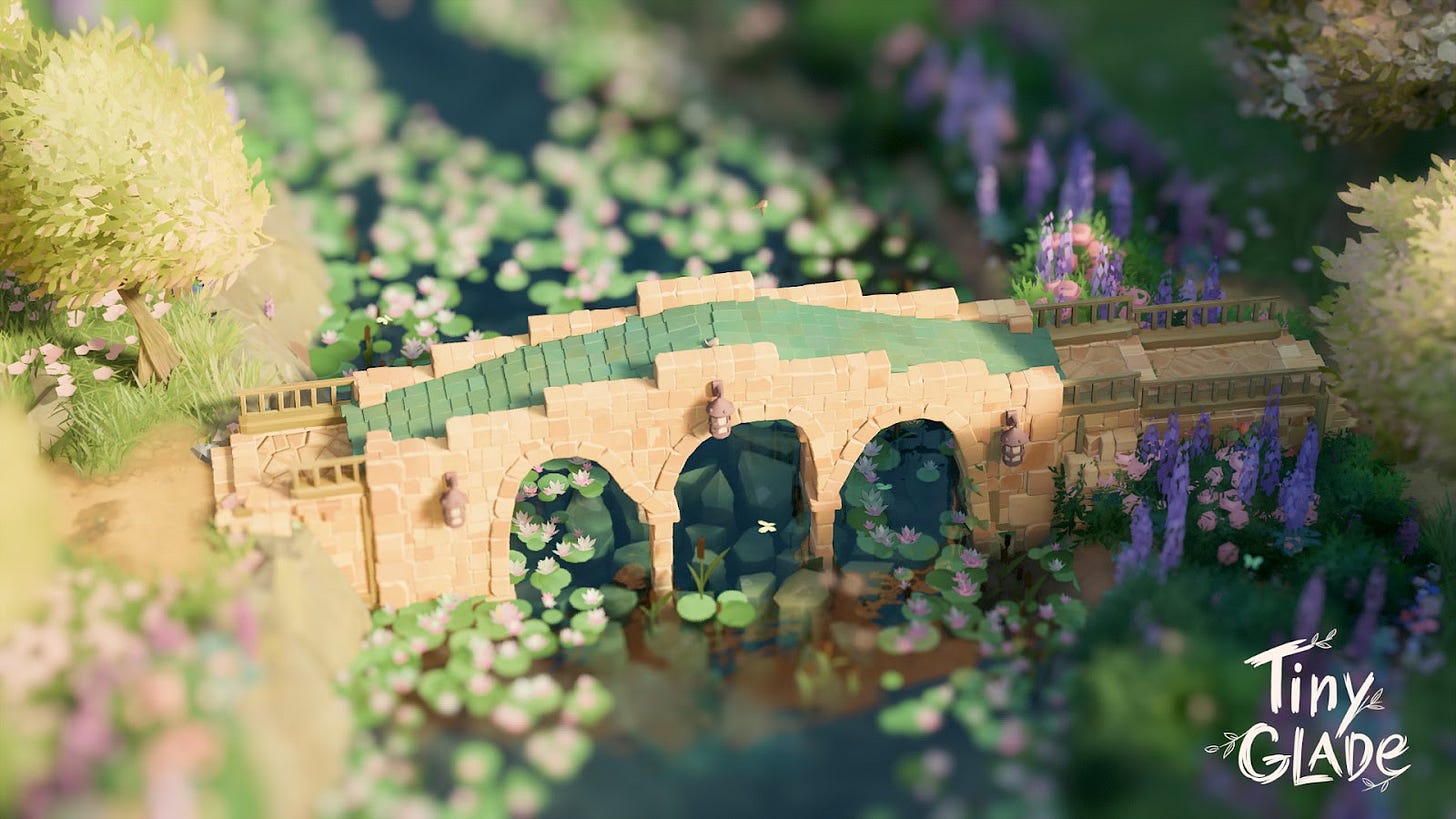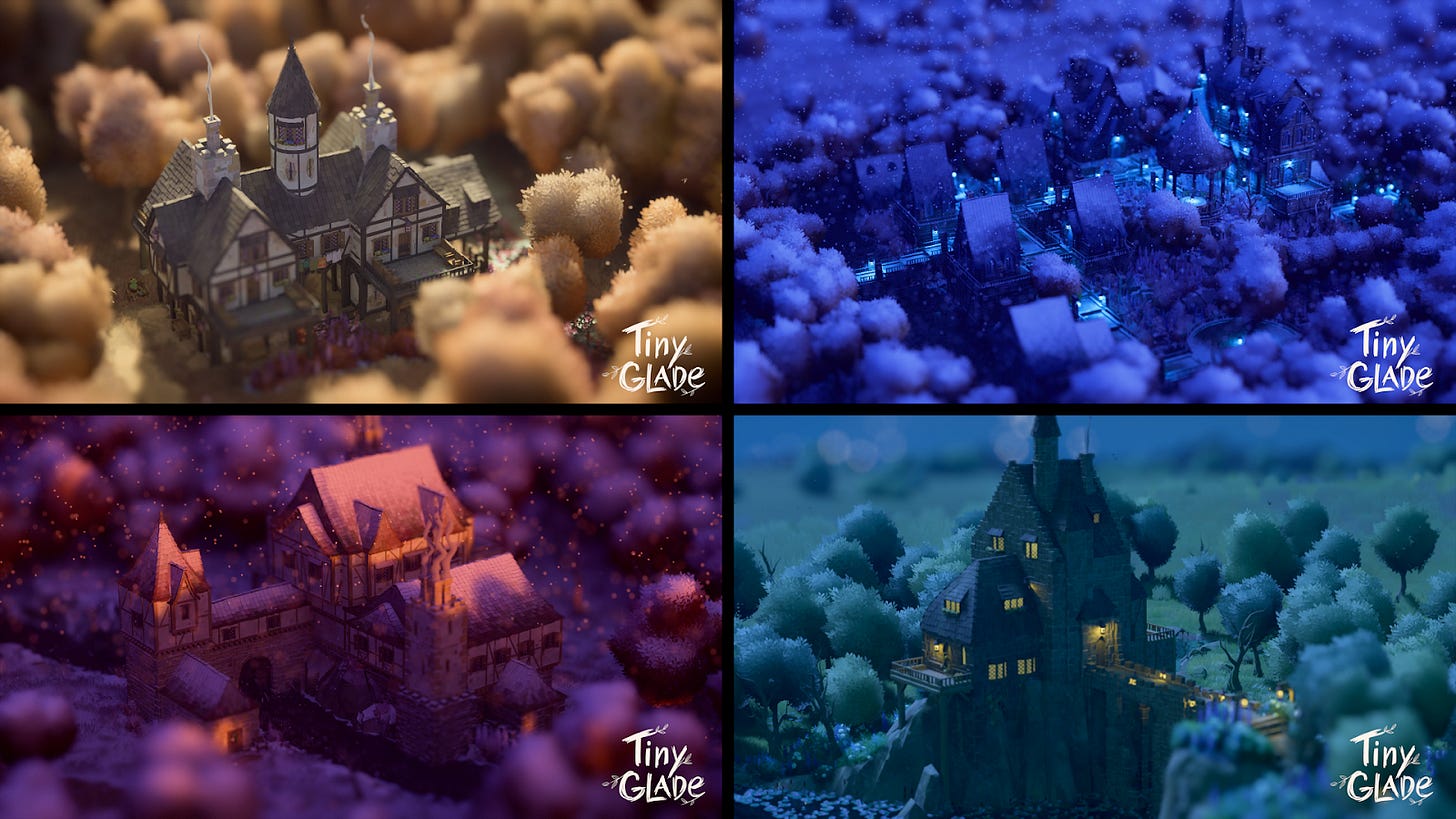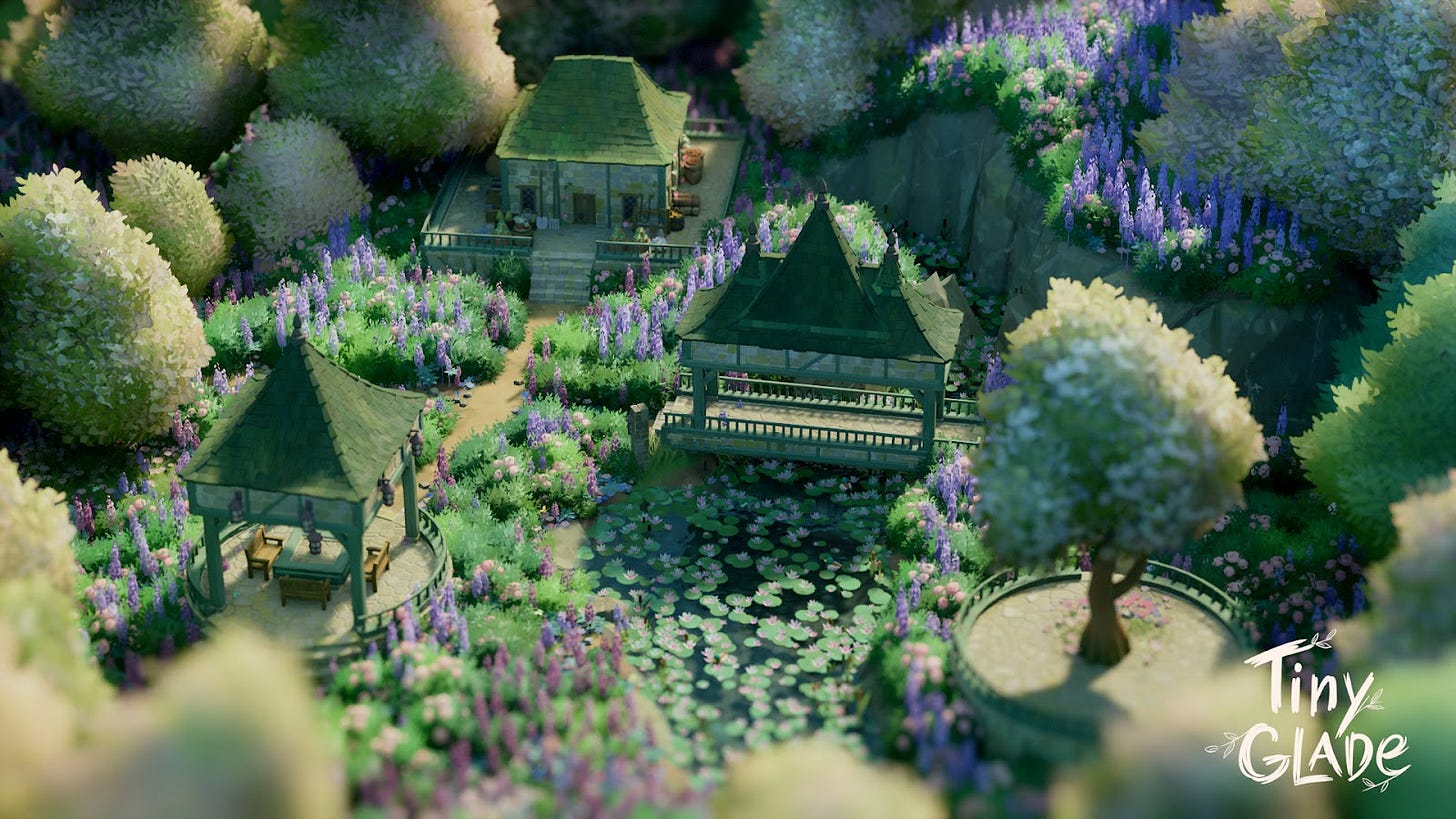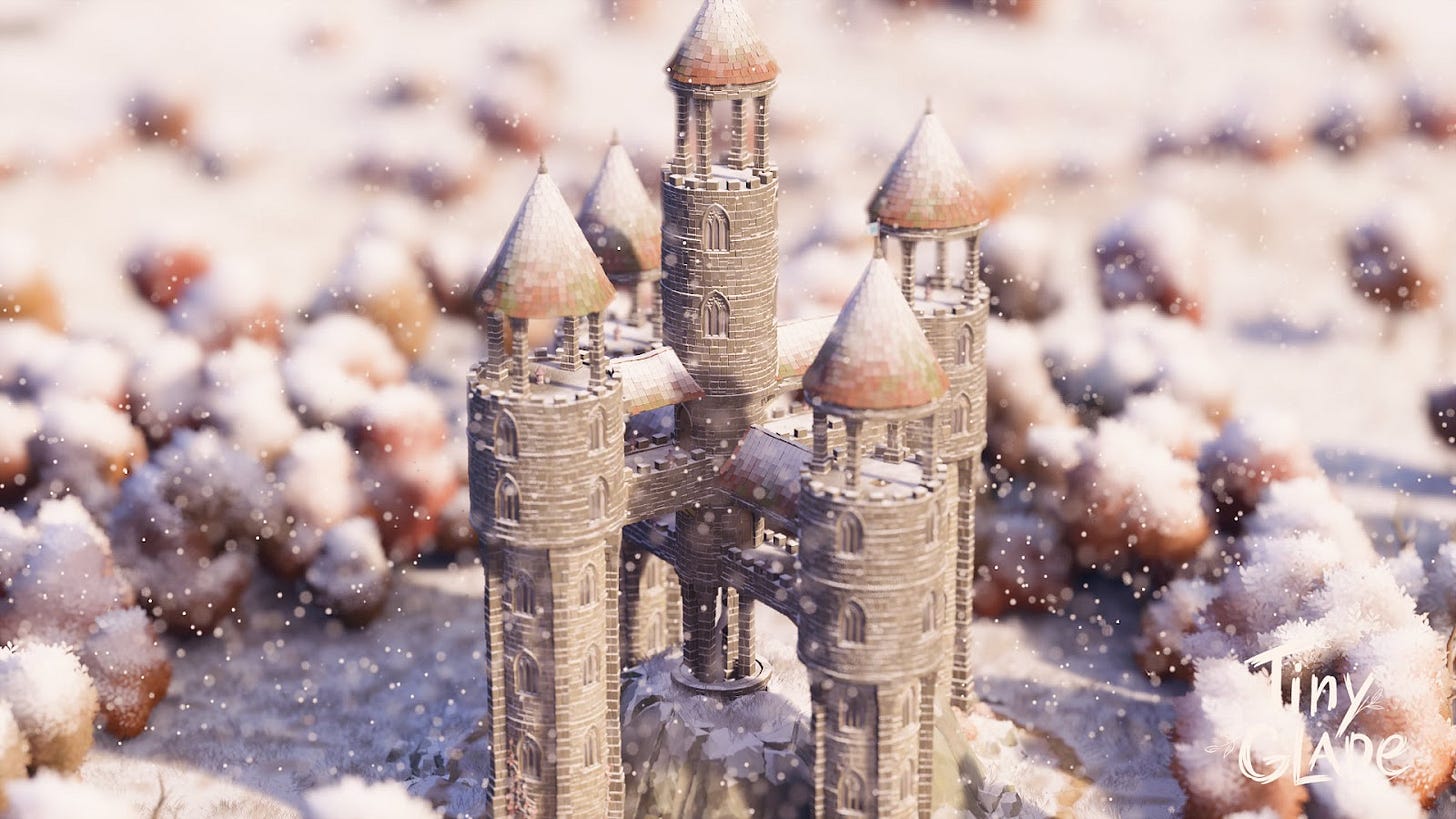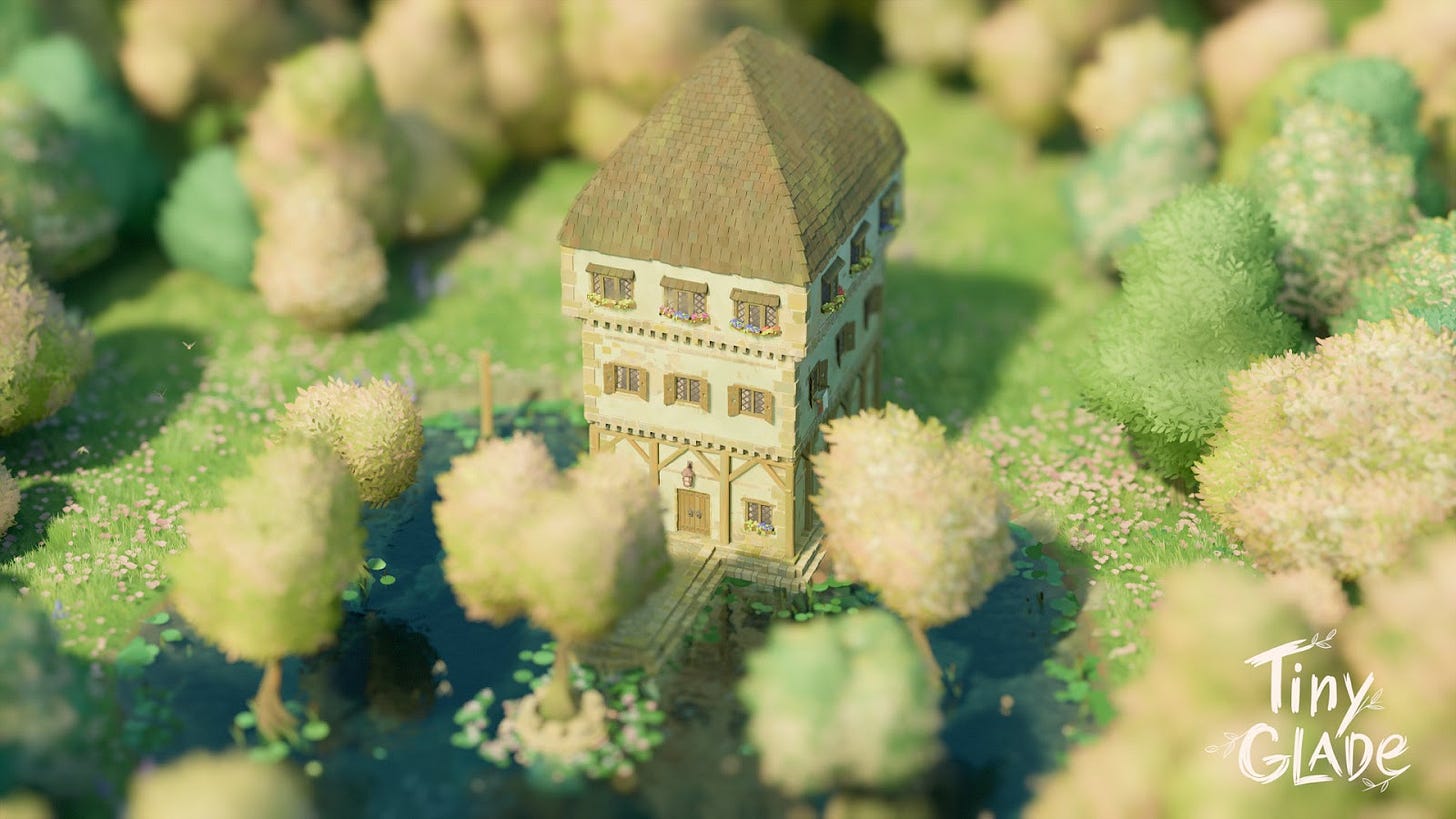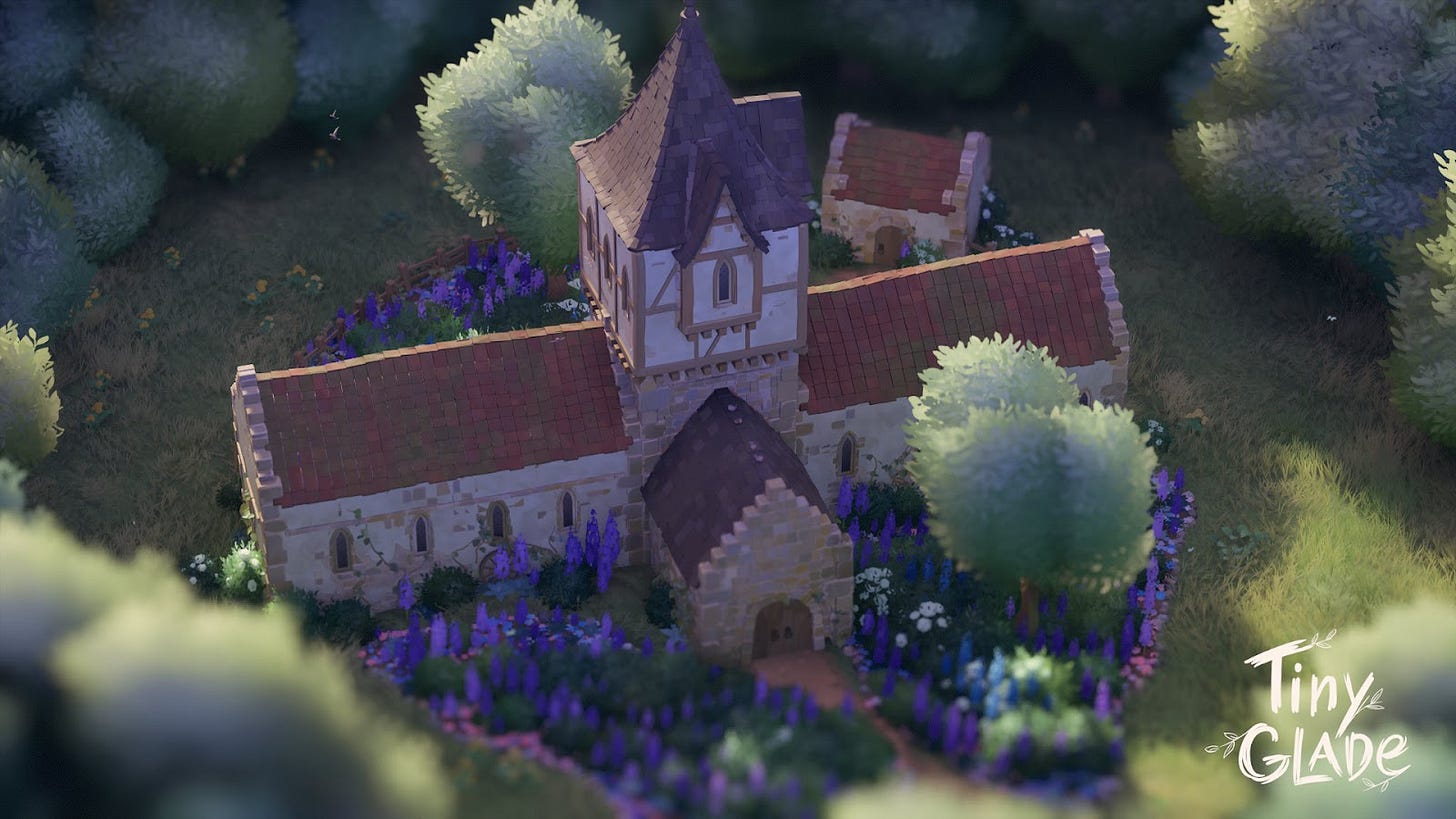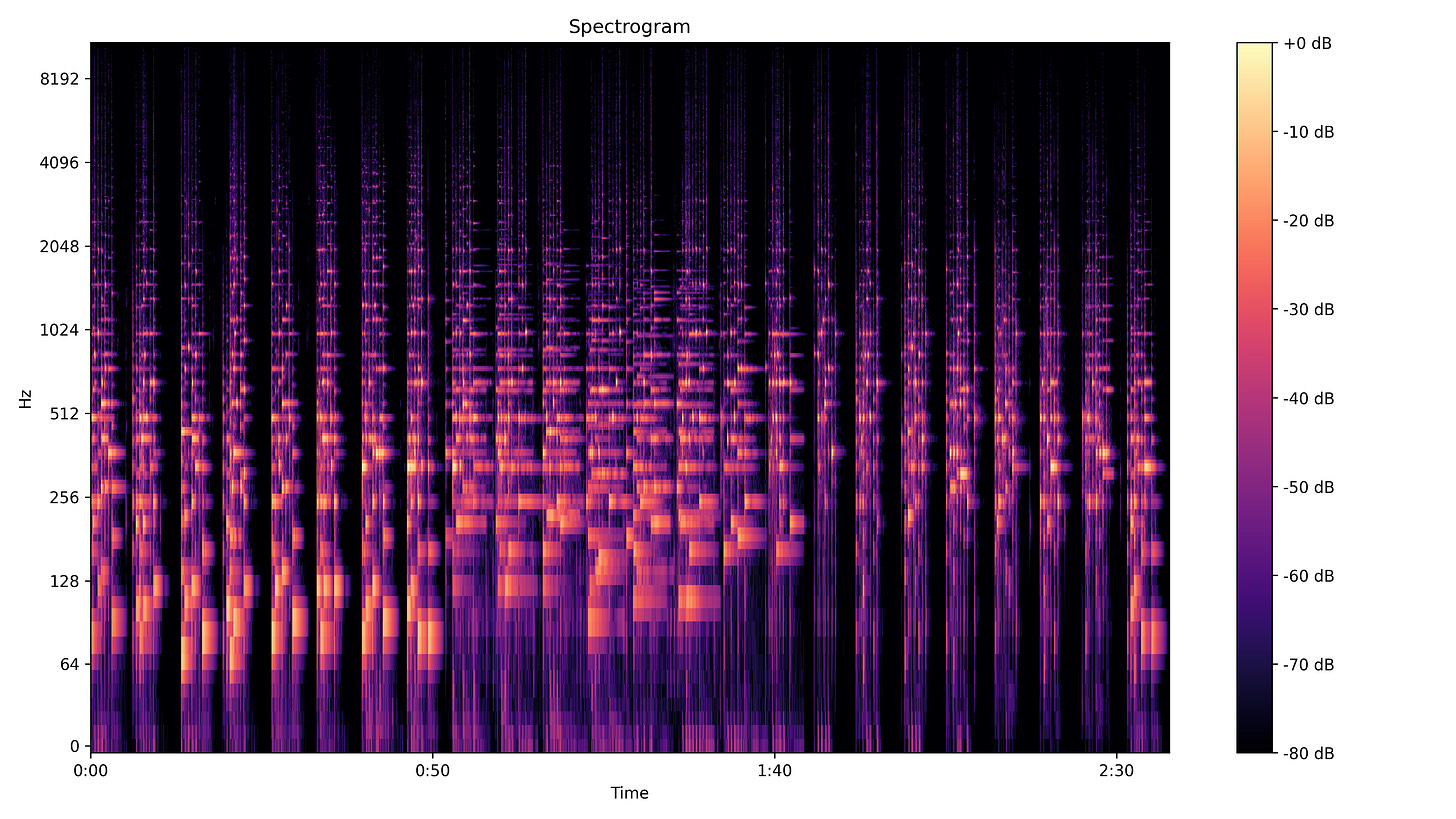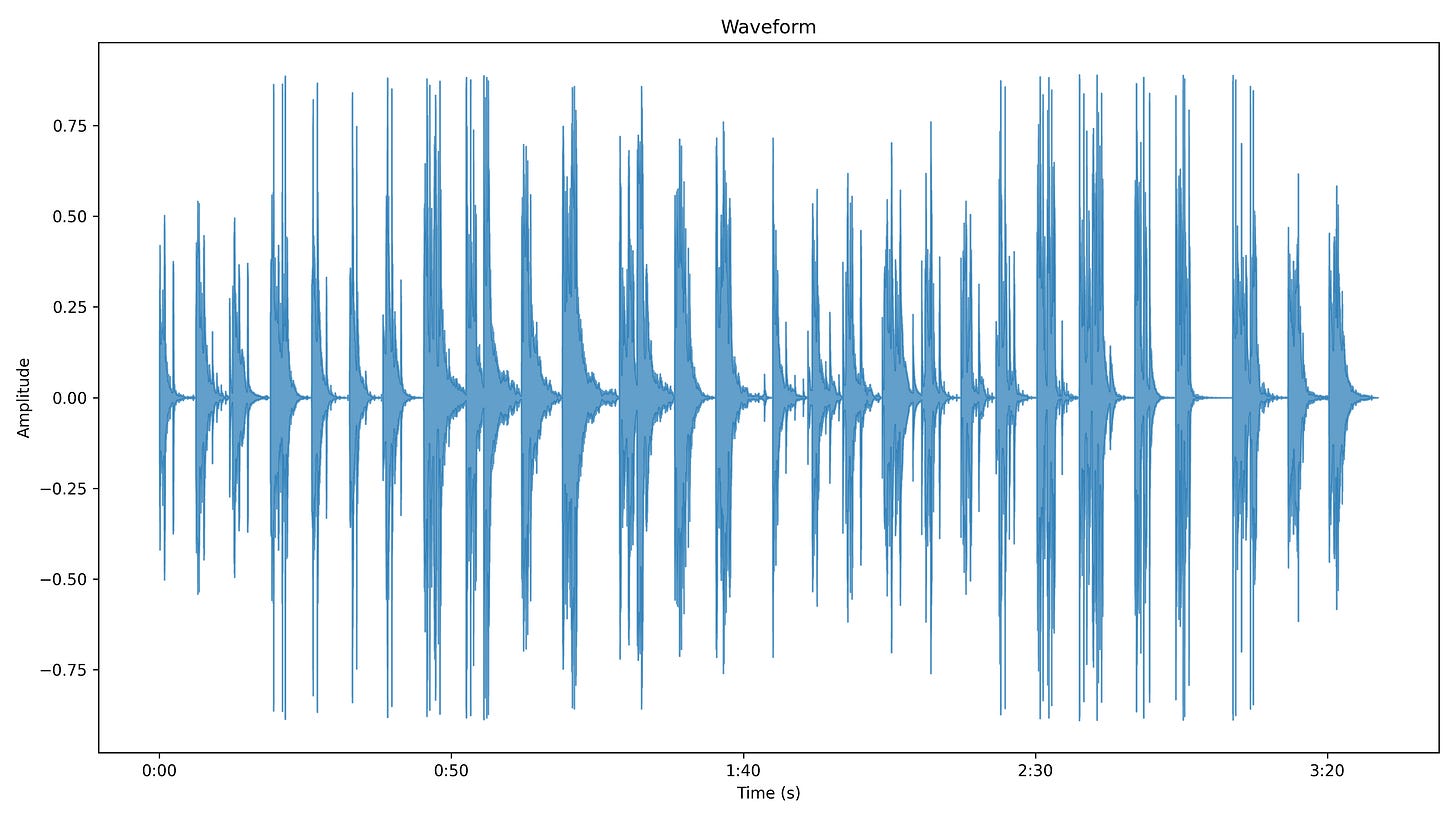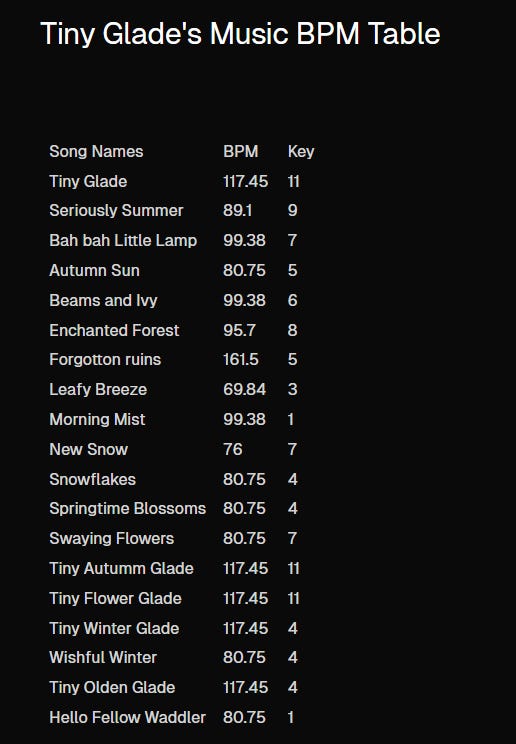Dissecting Creativity in Tiny Glade
But wait, how does the game keep the players engaged without any clear goals or a narrative?
The game starts in a small glade with a welcome screen and instructions on moving your camera around. You begin familiarizing yourself with the mechanics by tinkering with all the building tools you have at your disposal, hoping to create something beautiful.
Despite how limited the building tools you have compared to other creative building games, how does it manage to keep players engaged even without any clear goals or a narrative?
What makes the game so engaging without any narrative or goals?
“Tiny Glade is a small diorama builder where you doodle whimsical castles, cozy cottages & romantic ruins. Explore gridless building chemistry as the game adorns your glades with procedural detail. No management, combat, or goals: just kick back and turn forgotten meadows into lovable dioramas.”
This is the description you see on the Steam page. The developers set the expectation settings of the game as follows: it offers:
Expression and creativity through building and decorating your glades.
Exploratory play through tinkering with different tools and procedural details.
Relaxation by having no combat or goals.
On Expression and Creativity.
To help players enjoy the expressive and creative aspects of the game, the developers first need to address these key issues:
Balance of player agency.
The player’s lack of inspiration.
The player’s lack of ability.
The player’s lack of confidence.
The player’s lack of motivation.
Let’s deep dive. How Tiny Glades tackles the:
Balance of Player agency:
Obviously, it needs to offer a considerable amount of player agency. Without enough freedom to express themselves, players are unlikely to enjoy the experience. However, too much agency can also broaden the range of possibilities, which might create anxiety. This can overwhelm and confuse players about where to begin, making it harder for them to find inspiration.
Imagine a scenario where you go out to buy some clothes. You stumble upon a shop with tons of options like footwear, trousers, shirts, suits, jackets, and more, but there's no sales assistant (maybe it's fully automated, who knows), and you don't have a strong sense of fashion. What will you buy? It would be so confusing, right?
To make sure that the player does not get confused about what he should make and keep things within the difficult flow, there needs to be a balance between too much and too little player agency.
So, to make the decision-making of the expressive and creative aspects within a flow, it needs to have a balance between too much and too little player agency.
Here are some ways in which you can keep that balance:
First, you can rely on emergent mechanics instead of giving just a huge amount of options at the beginning to offer a considerable amount of player agency.
This does not overwhelm the player and also reinforces exploratory play( which we will talk more about in a while). If you look at Tiny Glades, you only have four Basic building structures:
Rectangular Buildings.
Circular Buildings.
Walls.
Fences
But with just two options, you already have tons of possibilities. Like using the rectangular building as tiles with no roofs to create curved staircases, or using the roof of the rectangular buildings to create an arch bridge. Or use them to create balconies for the house. Or use the path tool and fences to create little supports for your structure.
At first glance, it might look like it does not have a lot going on, but most of the uniqueness comes from the emergent mechanics of interacting with other tools you have.
Another way to tackle this issue is to give some sort of hint or an idea to the player what kind of tool or building piece it is, either through prompting or explicit instructions. Have you ever heard of something called “Lucid Dreamer”, “Japanese Joinery Gauges and Jigs”? Where will you place them in your house, and how would you use them?
But you can at least guess what futon beds mean, right? And if not, you can still guess what its use case would be and where it should be placed.
For example, there is a new game coming, called Whisper of the House (it’s demo is available on Steam). It is a game about helping people move, organize, and clean their spaces. You have a cute bot that gives you a decoration piece, which you can place in the room. Each decoration has a name and small descriptions associated with it. Like what is it, is it a TV, a painting, or a sofa?
The thing is, you get them in a sequence according to the room, based on their names, the player could guess where they would go through their intuition. Over here, instead of giving all of the decorations at once, you get them one by one with their names and small descriptions.
So whenever designing, building, or sandboxing games, always try to offer considerable player agency without overwhelming.
That being said, there is another issue that is somewhat related to this but needs to be tackled separately.
Player’s Lack of Inspiration:
I talked about how people could get confused when presented with a lot of choices all at once, but that is because they generally do not have any inspiration on what to make.
Human Creativity works on memories and intuition.
And intuition works on predictability and lessons learned from their memories. So generally, you want to make your game in such a manner that you would need to avoid things that are unpredictable, such as trees, terrain, grass, and water etc.
And man-made structures are generally easier to predict because we have seen them often, and their shapes are generally easier to recognize than the organic stuff. Lack of inspiration is also one of the reasons why it is generally harder for humans to do stuff from scratch than which already has a start. Because there is nothing to predict if you have a blank canvas.
Tiny glades tackle this issue by using these three methods:
Daily Themes: daily, it gives you a starting idea and suggests a word prompt on what you want to make for the daily theme. This narrows the possibility of what to make and gives some inspiration to the player. Now, to implement this properly, one must ensure that the prompt is neither too vague nor too narrow. This is because if it is too vague, people would have trouble figuring out how to make it, and if it is too narrow, people would have little room for self-expression. To keep it in balance, just ask yourself this question: how far does this prompt stray away from norms, and how easily can it be predicted? Because, like I said, creativity works on memories and intuition.
The glade always starts with some buildings and unique terrain whenever you create a new glade, giving the player an idea of what to transform it into.
And lastly Procedural elements help with things that are organic like terrain, water, flowers, and trees which are a bit harder for humans.
Player’s Lack of Ability:
This one is correlated to a lack of inspiration and our next issue, as finding inspiration for what to make would also be a part of ability, but it also includes how easily you can make something you imagine in your head. If you make something that does not look close to what you imagine, you will lose some of your confidence.
Tiny Glades handles this issue by restricting player agency to certain rules players would need to uphold and using procedural elements to do things that would be tedious.
For example, to make simple stairs, you would need to use a path tool for it to come. Or when you want to transform your fences into archways, you would need a path that goes through its procedural elements to help in creating lakes, connecting buildings, creating fences and walls while still looking great.
You could not go wrong with how you want to build; no matter how unrealistic it looks, it would still look beautiful, as the game handles the backend using procedural elements. Similarly, this handles the lack of confidence issue as well, since whatever you make will always end up looking good, and your confidence will not go down at all.
The other ways creative building genre games handle this are through copy-pasting and a grid mechanism. Most of the human-made structures are uniform but it is quite hard to create an exact or similar object without any measurements. Okay, one or two times you would be fine because it might be hard but it would still be doable. But when you want to say create 8 or 10 replicas with just eye guessing things get difficult.
This is one flaw of Tiny Glade. It might just be me but I found the absence of a copy pasting mechanism a little annoying.
Player’s Lack of Confidence:
Like I mentioned, it is a bit related to lack of ability but not entirely, one could have some ability but the expectations they have of their self-image might be different such that they might not be able to make stuff whatever they imagined, so this lack of confidence needs to be tackled separately from the lack of ability.
A method for tackling this is the idea that “ignorance is bliss, and keep them in the illusion of growth.”
As long as they are is no comparison of creations between different individuals and keep them in the illusion that their creative skills are increasing as they learn new concepts, their confidence should theoretically keep growing.
And since creations are always personal, all of them (as long as they look visually good) should feel special to the creator. And if they need inspiration, they could look for other creations made by different skilled creators, at their own pace, whenever they feel comfortable.
Tiny Glades uses a similar method. Like I mentioned above, no matter what you make, it would be beautiful using procedural tools. And since there is no one to judge your creations except you, your confidence would not go down and you would constantly learn new concepts through exploratory play and experience growth, so is your confidence until there is nothing to explore further in the game.
Player’s Lack of Motivation:
Our last issue, which we need to tackle, is the players’ lack of motivation. This deals with why one should make something. What is their motive for engaging in creating something? This motivation for playing something is set based on the expectation settings set for you.
In our case, tiny glades tackle the lack of motivation using these methods:
Set the expectation settings for relaxation through tinkering after getting tired from your work. It would appeal as escapism to the audience.
Like I said, creations are always personal, and you would generally want to experience and share them. The tiny glades provide a photo system that lets you do just that. In the photo mode, you can experience your glade in first person, and from a flying drone. You can adjust the overall color of the image, choose how much blur should be outside of the image, and how big the focus should be. You could also choose from various presets as well. You can also add a filter that completely changes the look of your glade.
And generally, this leads to having that sense of belongingness as well. And there is a small community of creative people on Discord and Reddit who play and share their creations.
Lastly, like I said, when it uses a sense of growth to increase your confidence, that also acts as a motivation for why they are playing the game as well.
Here is a GDC video that talks in more detail about how to solve these.
This is how Tiny Glades tackles these issues and handles creative self-expression. Now you guys would be wondering why go through all the trouble of handling creativity and self-expression properly in games. Here are the reasons why:
It encourages a sense of belonging.
It leaves a lasting and memorable impact on the player and increases the word of mouth even if the engagement was short.
Like I said, creations are always personal, so it always has a chance to resonate with a lot of people.
Now, how does it deliver on exploratory play?
Exploratory play is an intrinsic motivator that refers to fulfilling curiosity by encouraging players to experiment, discover mechanics, and learn by doing rather than through explicit instruction. This is a very powerful motivator that is used almost everywhere.
When it comes to exploratory play, it is not just restricted to locations, lore, and story, but the emergent mechanics as well.
For example, in Potion Craft: Alchemy Simulator, you explore different types of ways to reach one or multiple desired effects using different elements. Or take Wizard of Legends, where you experiment with different types of arcanas to create widely powerful builds and see what works and what does not.
Now you would be wondering how to implement this motivator in the right way, such that it increases engagement and memorability.
If you look closely at the examples I mentioned above, you would see there are a few things in common:
There is always some sort of feedback to the player's actions. It could be different visual effects, sound effects, rewards, or some sort of emergent mechanic.
It is an unstructured form of play where there is no explicit goal for what to do exactly.
It also heavily relies on the player's intuition.
So, when designing exploratory play for your game, keep these things in mind:
You must ask yourself this: how related or common is it within the game sense and the general knowledge? And how much do you want it to be related? The more relatable it is, the easier it would be to figure out what to do based on his intuition.
Good exploratory plays rely heavily on environmental storytelling and good level design.
It needs to have a flow of difficulty based on the concepts the player has learned so far and how they can apply them using their game sense or general knowledge.
It needs to have a high level of player agency.
And lastly, no form of exploratory play is infinite.
So now the main question is how Tiny Glades delivers exploratory play through tinkering?
Whenever you use any tool, there is some sort of sound effect feedback, and everything happens in real time. Whenever you are adjusting a building’s dimensions, roofs, adding windows, chimneys, decorations, it all happens in real time. Or when you are adding water to your glade, placing flowers and trees, or adjusting the slope of your landscape, it all happens in real time.
And each has a very matching and real-life sound effect to it, either when moving, adjusting, or when you place them. This gives a very responsive game feel when building stuff.
The way it introduces you to the game’s mechanics also plays a great role in all this. It starts with a welcome screen and prompts you to run a path through the wall and see what happens. After that, it teaches you about cameras, on how to pan, zoom, and rotate your camera. After that, you just discover things by tinkering with the tools you have at your disposal. It pops up hints whenever you use a new tool, like the window or the terrain.
The minimalist UI of tiny glade also plays an important role in enhancing the immersion of the game. There is absolutely no ui besides those hints popup, and the tool box whenever creating something inside a glade. This enhances the unity aspect of the game when building stuff.
And, how does it deliver on Relaxation?
Relaxation games refer to games that often have low stakes and generally have some sort of progression.
The key characteristics of a relaxation game are:
There is no win nor lose state in the game. It means there is no true end to the game nor can you lose anything that sets you back.
There is always some sort of either intrinsic or extrinsic progression in the game.
So whenever designing a relaxation game, one must take into account, how does the player grow in the progression and how do I design for the pacing of the game according to the player.
With this in mind, how does Tiny Glades deliver relaxation?
First its artstyle has a very whimsical look to it which indicates the clumsiness and let the player know that there are no stakes in this game they would need to worry about.
The growth of the player in this game is entirely intrinsic as players discover more and more new interactions in the game, which helps them make better glades.
Here is a video that discusses relaxation in games:
And it uses something called entrainment through its visuals, music and sound effect to make the player engaged at the subconscious level. This concept helps in reinforcing both relaxation and the exploratory play aspect of the game.
On Entrainment, exploratory play, and relaxation.
Entrainment occurs when the brain synchronizes its neural oscillations with external rhythmic stimuli, often aligning with specific frequency ranges tied to mental states.
For example, lofi music can trigger entrainment by influencing brainwave states, due to its repetitive, soothing rhythms and tempos. This makes the brain go into the flow state and becomes relaxed and focused toward whatever it is doing.
For it to trigger relaxation and focus, it needs to be as follows:
Tempo: Lo-fi music typically ranges from 60 to 90 BPM. This aligns with the resting heart rate (60–100 BPM) and promotes relaxation by entraining brainwaves to slower rhythms. For specific entrainment:
Alpha brainwaves (8–12 Hz, relaxed focus): Music around 60–80 BPM can encourage alpha wave activity, as the brain syncs to the beat’s periodicity (e.g., 1–2 beats per second approximates 8–12 Hz).
Theta brainwaves (4–8 Hz, deep relaxation/meditation): Slower lo-fi tracks, closer to 50–70 BPM, may facilitate theta states, especially with ambient, drone-like textures.
Frequency: It should be around 100 to 500 Hz with warm and muffled tones.
Structural Elements: Repetitive chord progressions, simple drum patterns, and ambient textures in lo-fi enhance entrainment by providing predictable, cyclical stimuli.
Here is an album containing music that uses theta waves.
But how does this help in games, specifically Tiny Glades? The developers of the game might have created their music and sound effects without intentionally considering the concept of entrainment, but some of its effects are still present unintentionally, as there are similarities with lo-fi music.
Here is a playlist of Tiny Glade (Original Video game track)
Take Autumn Sun, Snowflakes, and Tiny Flowery Glade, for example. If you look at their waveforms, spectrograms, and strength onsets, you would see a pattern. Instruments used for the music are the flute and trumpet. And they used real-life sound effects for bricks, bird chirping, grasshopper singing, leaves rustling, etc.
If you look at their spectrogram you would see that their frequency is between 1000 and 100 hz with major activity between 250 to 500. Second, you would see that there is a moment of silence between each instrument.
If you look at their waveforms, you would see that they follow a rhythmic pattern with different varying patterns. And you could see that there is a moment of silence in between each of the waves and each wave has a very similar pattern.
Also, their BPM was
Autumn Sun: 80.75
SnowFlakes: 80.75
Tiny Flowery Glade: 117.45
Here is the BPM and chroma key table for the rest of the music:
Now, since there are a few songs that have a BPM of higher than 100 bpm, which is unusual for lo-fi music, it shows that they unintentionally trigger similar effects of entrainment, specifically the alpha brainwave.
This is why whenever you try to build anything, you would feel relaxed and joyful when trying to create something in a tiny glade. This helps in exploratory play as it increases focus, which in turn increases immersion.
Despite all this, why does the game have a low average and median playtime?
So we have seen so far that the game delivers creative expression, relaxation, and exploration brilliantly to engage the player. But last time I checked it has a total average playtime of 12 h 34 min and a median playtime of 54 min. The huge gap between the average playtime and median playtime is due to some hardcore players spendings 10 hours to even 20 hours and that shifted its average playtime, but why is the casual playtime so low? Was it intended?
The one reason I could think of is that it ran out of stuff to offer for exploratory play.
First of all, you have basic building structures. This includes rectangular buildings, circular buildings, fences, and walls. You can build rectangular and circular buildings on top of each other to create unique buildings, and the game takes care of details that look ugly using procedural elements. You can also use them as foundations, bridges, and balconies.
Then you can create walls and fences using splines. You can cut them in the middle to create new walls and fences. You can also change their overall look using the path tool. Like turning them into archways. You can also use the path tool to create stairs and doors near rectangular and circular buildings to create stairs and doors.
Speaking of changing their look, you can also change their color and other functionalities like railing and materials using the color palette tool. Then you also have some decorative pieces like square windows, curved windows, wall holes, lanterns, flags, and chimneys. You can change their overall look using the color palette tool, too. You can combine some of them, like holes and windows, to create bigger variations of them.
By the way, you get more decorative pieces that you can place outdoors by clicking on those windows. Then you have some tools related to changing the inorganic stuff of your glade, like slopes, water, trees, and flowers. Lastly, you have an eraser tool, a “Sun time and direction changing tool”, and a photo mode.
Since there were not many tools to begin with that would last for quite a long time, there was not much to tinker with.
But is it a bad thing, though? Not necessarily! Even if the playtime was short, it was still meaningful to many people, as I said, creations are always personal, and there are still people who played for the sake of creating stuff. And it still has an overwhelmingly positive review on Steam. So, all things considered, it is still a pretty fun game to play.
Conclusion
Tiny Glade weaves together exploratory play, player creativity, expression, and relaxing elements using procedural tools to create a wonderful and memorable short experience.
It demonstrates that by making each element of the game, like the music, sound effects, and feedback so consistent and coherent, it can create a very short, fun and relaxing experience for players.
And I had a blast writing this piece. Until the next one!


